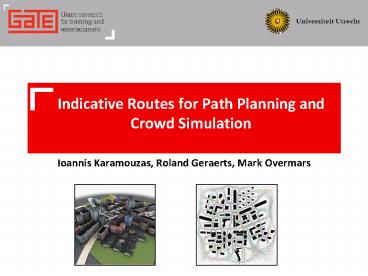Ioannis Karamouzas, Roland Geraerts, Mark Overmars - PowerPoint PPT Presentation
Title:
Ioannis Karamouzas, Roland Geraerts, Mark Overmars
Description:
Use clearance information as a representation of the corridor. Local ... One CPU core used. 3000 characters, CPU usage 26%, FPS 33. Crowd Simulation Video ... – PowerPoint PPT presentation
Number of Views:58
Avg rating:3.0/5.0
Title: Ioannis Karamouzas, Roland Geraerts, Mark Overmars
1
Indicative Routes for Path Planning and Crowd
Simulation
- Ioannis Karamouzas, Roland Geraerts, Mark Overmars
2
Path Planning
- What is path planning
- Steer character from A to B
- Computer games and path planning
- Fast and flexible
- Real-time planning for thousands of characters
- Flexibility to avoid other characters and local
hazards - Individuals and groups
- Natural Paths
- Smooth
- Collision-free
- Short
- Keep a preferred amount of clearance from
obstacles - Flexible
- ..
3
Path Planning
- Maintain suspense of disbelief
- Realistic graphics and physics
- Still though, the path choices that characters
make are poor
4
Errors in Path Planning
5
Existing Algorithms
- Grid-based A Algorithms
- Computational expensive
- Aesthetically unpleasant paths
- Waypoint graphs
- Hand designed
- Do not adapt to changes in the environment
- Navigation Meshes
- Automatic construction is slow
- Paths need to be smoothed
6
Existing Algorithms
- Local Methods
- Flocking Reynolds, 1987 1999,
- Helbings Social Force Model Helbing et al,
2000 - Reactive style planners
- Local methods fail to find a route
- Suffer from local minima problems
- Lead to repeated motion
7
The Indicative Route Method
- In real life, people
- Do not plan an exact path, but
- A preferred/desired global route
- A path planning algorithm should produce
- An Indicative Route
- Guides character to its goal
- A corridor
- Allows for flexibility
8
The Indicative Route Method
- The IRM method in action
- A collision-free indicative route determines the
characters preferred route - A corridor around this route defines the walkable
area for the character - A smooth path is generated using a force-field
approach
9
Computing Corridors
- The Corridor Map
- Introduced by Geraerts and Overmars, 2007
- Provides a system of collision-free corridors
- Corridor sequence of maximum clearance disks
- The Corridor Map is computed as follows
- The Generalized Voronoi Diagram is approximated
using GPU Hoff et al, 1999 - Clearance additional info is stored
3D Environment
Skeleton of the map
Corridor
10
Computing Corridors
- Computing the Corridor Map
- Only required during preprocessing
- Very fast (50 ms, NVIDIA GeForce 8800 GTX)
- Compute a corridor
- Retract the indicative route to the Generalized
Voronoi Diagram - Find corresponding path in diagram
- Use clearance information as a representation of
the corridor
11
Local Navigation in IRM
- Boundary force
- Find closest point on corridor boundary
- Increases to infinity when close to boundary
- 0 when clearance is large enough (or when on GVD)
- Steering force
- An attraction point moves along the indicative
route - Attracts the character with a constant steering
force - Noise force
- Create variation in paths
- Perlin noise is used
12
Local Navigation in IRM
- Collision Avoidance Force
- Avoid collision with other characters and moving
entities - Helbings model can be used
- Additional models can be easily incorporated
- Obtain the final path
- Force leads to an acceleration term
- Integration over time, update velocity/position/at
traction point - Results in a smooth (C1-continuous) path
13
IRM method
- Resulting vector field
- Indicative Route is the medial axis
14
Creating Indicative Routes
- Use the Generalized Voronoi Diagram
- Retract start and goal
- Find shortest path (using A)
- The corridor is obtained immediately
- Use a network of Indicative Routes
- Created by level designer
- Voronoi-Visibility Complex Wein et al, 2005
- A on coarse grid
- Additional information can be incorporated
- For example flow into account
- Use the notion of Influence Regions
15
Crowd Simulation
- Method can plan paths of a large number of
characters - Goal oriented behavior
- Each character has its own long term goal
- When a character reaches its goal, a new goal is
chosen - Wandering behavior
- Attraction points do a random walk on the
indicative network - Experiments
- Goal-oriented behavior
- Simulation ran for 1000 steps
- Each step calculates 0.1s of simulation time
16
Crowd Simulation - Experiments
- Test Environment
City environment
2D footprint (640 ms)
17
Crowd Simulation - Experiments
- Performance
- 2.4 GHz Intel Core2 Duo, 2 GB memory
- One CPU core used
- 3000 characters, CPU usage 26, FPS 33
18
Crowd Simulation Video
19
Current Research
- Global behavior
- Incorporating influence regions
- Types of behavior (shopping, tourists, )
- Further improving the local methods
- Take mood and personality into account
- Dealing with small groups
- Observing and modeling paths of real humans
- Motion capture data
- Tracking pedestrians
- Evaluation of the results
- Projects Website
- http//people.cs.uu.nl/ioannis/irm































